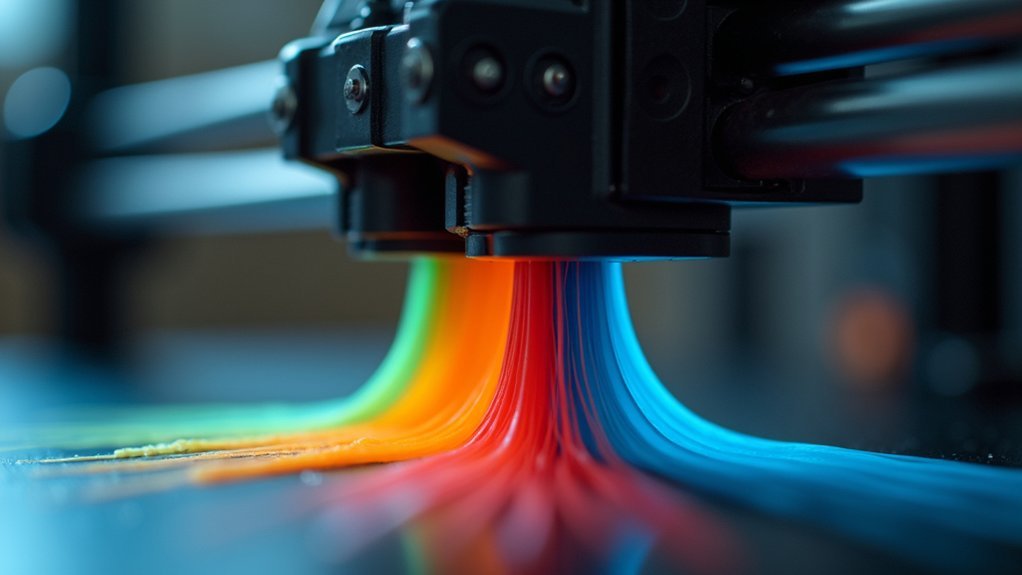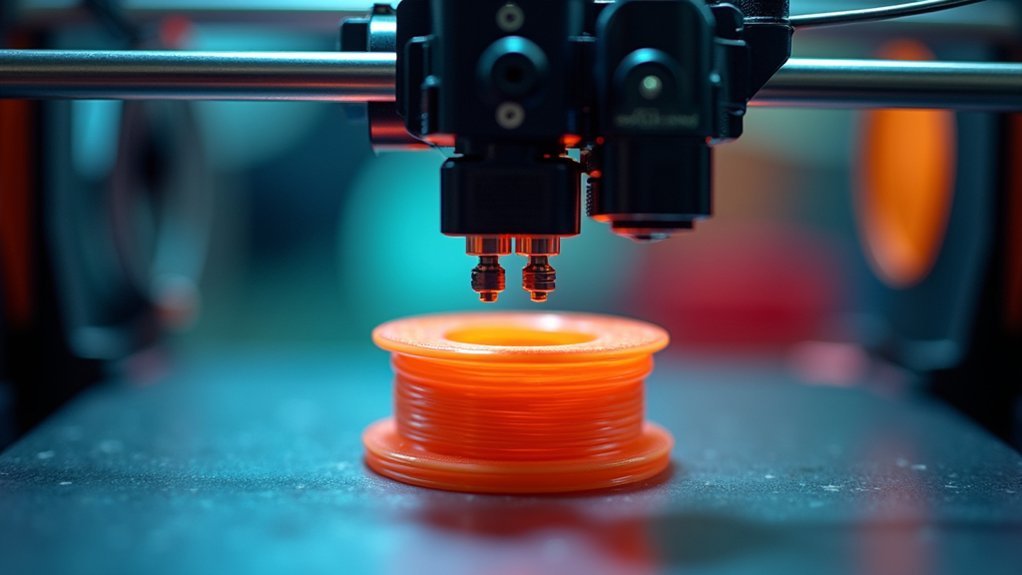You’ll achieve ideal dual extruder speeds by focusing on three key techniques: first, enhance your slicer settings by configuring extruder switch parameters to minimize nozzle movement time and adjusting temperatures for each material type. Second, properly configure prime towers and retraction parameters, setting retraction speeds between 30-50 mm/s with 1-5mm distances to reduce oozing during switches. Third, balance extrusion rates by testing each extruder at 400 mm/min baselines and using M203 commands to set speed limits. These strategies work together to unlock even more advanced enhancement possibilities.
Optimize Slicer Settings for Dual Extruder Print Paths

When you’re working with dual extruders, optimizing your slicer settings becomes essential for achieving faster print speeds without sacrificing quality.
Configure your extruder switch settings to minimize movement time between nozzles, effectively reducing non-printing travel time. You’ll want to adjust temperatures and speeds for each extruder based on your specific materials, ensuring efficient material flow while cutting print time.
Utilize prime towers and ooze shields in your slicing software to manage filament oozing and maintain clean print paths during material switches.
Experiment with different infill patterns and densities to find the sweet spot between speed and structural integrity for your dual materials.
Regular software updates provide new optimizations specifically designed for Dual Extruders setups, maximizing your print path efficiency.
Configure Prime Towers and Retraction Parameters
Building on your ideal slicer settings, proper configuration of prime towers and retraction parameters directly impacts your dual extruder’s printing efficiency and quality.
Prime towers allow inactive nozzles to purge excess filament before printing, minimizing oozing and stringing. Set your prime tower height to match the maximum expected ooze from your inactive nozzle for controlled material deposition.
Prime towers enable inactive nozzles to purge filament efficiently, reducing oozing and stringing for cleaner dual extruder prints.
Configure your retraction settings with speeds between 30-50 mm/s to reduce filament oozing during extruder switches. Adjust retraction distance to 1-5 mm based on your material and nozzle size, preventing backflow when the drive gear reverses.
Monitor temperature settings for each filament, as different materials require varying ideal temperatures that influence oozing and retraction effectiveness during dual extrusion operations.
Balance Extrusion Rates Between Multiple Extruders

Since different extruders often exhibit varying flow characteristics, you’ll need to carefully balance their extrusion rates to prevent quality issues like under-extrusion or over-extrusion across your dual-material prints.
Set maximum extrusion speed limits using M203 commands in your slicer, preventing slower extruders from bottlenecking your printing process. Test each extruder at approximately 400 mm/min for 0.3mm nozzles to establish baseline performance.
| Parameter | Extruder 1 | Extruder 2 |
|---|---|---|
| Max Speed (mm/min) | 400 | 350 |
| Motor Current (%) | 85 | 90 |
| Temperature (°C) | 210 | 220 |
| Retraction Distance | 4.5mm | 5.0mm |
| Retraction Speed | 45mm/s | 40mm/s |
Calibrate each extruder individually by adjusting motor current and temperature settings. Fine-tune gear dynamics and drive mechanisms, especially when mixing flexible and rigid materials to maintain synchronized flow rates.
Frequently Asked Questions
What Is the Best Slicer for Dual Extrusion?
You’ll find Simplify3D and PrusaSlicer are top choices for dual extrusion, offering advanced customizable settings. Cura’s also excellent with its user-friendly interface, while MatterControl provides great visualization for planning your dual-material prints effectively.
What Is the 45 Degree Rule in 3D Printing?
You should follow the 45-degree rule by keeping overhangs at maximum 45-degree angles to prevent sagging and reduce support material needs, ensuring smoother surfaces and better print quality.
How Do I Optimize My 3D Printer Speed?
You’ll optimize speed by increasing layer height to 0.2-0.4mm, maximizing travel speeds to 150-300mm/sec, using larger nozzles, and fine-tuning print speeds per material while maintaining quality standards.
How Fast Can Raise3d Pro3 Print?
You can achieve up to 150 mm/s with your Raise3D Pro3, though you’ll typically print between 50-100 mm/s for ideal quality. The dual extruders let you print complex designs efficiently.





Leave a Reply